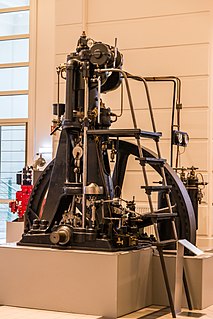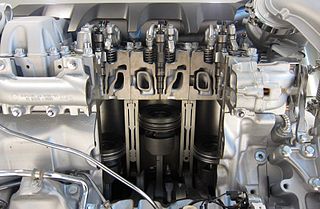This article needs additional citations for verification .(July 2012) |
Frederick Lamplough was a British engineer who invented the diesel injector (Unit Injector).
This article needs additional citations for verification .(July 2012) |
Frederick Lamplough was a British engineer who invented the diesel injector (Unit Injector).
He formed the company Lamplough & Son Ltd in 1899. [1] It was based in north-west London.
The company made aeroplanes, and internal combustion aviation turbines. The aircraft it built were very primitive, similar to craft seen in Those Magnificent Men in their Flying Machines , and not of the conventional shape seen today. The company also made aircraft rotary engines.
The British patent No. 1517 was issued to him in 1911 for a diesel injection system.

The diesel engine, named after Rudolf Diesel, is an internal combustion engine in which ignition of the fuel is caused by the elevated temperature of the air in the cylinder due to mechanical compression; thus, the diesel engine is a so-called compression-ignition engine. This contrasts with engines using spark plug-ignition of the air-fuel mixture, such as a petrol engine or a gas engine.

Fuel injection is the introduction of fuel in an internal combustion engine, most commonly automotive engines, by the means of an injector. This article focuses on fuel injection in reciprocating piston and Wankel rotary engines.

The radial engine is a reciprocating type internal combustion engine configuration in which the cylinders "radiate" outward from a central crankcase like the spokes of a wheel. It resembles a stylized star when viewed from the front, and is called a "star engine" in some other languages.

The Cessna 172 Skyhawk is an American four-seat, single-engine, high wing, fixed-wing aircraft made by the Cessna Aircraft Company. First flown in 1955, more 172s have been built than any other aircraft. It was developed from the 1948 Cessna 170 but with tricycle landing gear rather than conventional landing gear. The Skyhawk name was originally used for a trim package, but was later applied to all standard-production 172 aircraft, while some upgraded versions were marketed as the Cutlass.

The English Electric Company Limited (EE) was a British industrial manufacturer formed after the armistice of World War I by amalgamating five businesses which, during the war, had been making munitions, armaments and aeroplanes.

Common rail direct fuel injection is a direct fuel injection system built around a high-pressure fuel rail feeding solenoid valves, as opposed to a low-pressure fuel pump feeding unit injectors. High-pressure injection delivers power and fuel consumption benefits over earlier lower pressure fuel injection, by injecting fuel as a larger number of smaller droplets, giving a much higher ratio of surface area to volume. This provides improved vaporization from the surface of the fuel droplets, and so more efficient combining of atmospheric oxygen with vaporized fuel delivering more complete combustion.

Gasoline direct injection (GDI), also known as petrol direct injection (PDI), is a mixture formation system for internal combustion engines that run on gasoline (petrol), where fuel is injected into the combustion chamber. This is distinct from manifold fuel injection systems, which inject fuel into the intake manifold.
Lucas Industries plc was a Birmingham-based British manufacturer of motor industry and aerospace industry components. Once prominent, it was listed on the London Stock Exchange and was formerly a constituent of the FTSE 100 Index. In August 1996, Lucas merged with the American Varity Corporation to form LucasVarity.
In internal combustion engines, water injection, also known as anti-detonant injection (ADI), can spray water into the incoming air or fuel-air mixture, or directly into the combustion chamber to cool certain parts of the induction system where "hot points" could produce premature ignition. In jet engines it increases engine thrust at low speeds and at takeoff.
Henry Meadows, usually known simply as Meadows, of Wolverhampton, England were major suppliers of engines and transmissions to the smaller companies in the British motor industry. Founded in 1920 in Park Lane, Wolverhampton, as a car gearbox maker, they expanded into petrol engines in 1922 and in the 1930s built a large factory in Fallings Park, Wolverhampton.
A throttle is the mechanism by which fluid flow is managed by constriction or obstruction.

The Diamond DA40 Diamond Star is an Austrian four-seat, single-engine, light aircraft constructed from composite materials. Built in both Austria and Canada, it was developed as a four-seat version of the earlier DA20 by Diamond Aircraft Industries.

Ricardo PLC is a British publicly listed company named after its founder, Sir Harry Ricardo, originally incorporated and registered as Engine Patents Ltd. in 1915. Ricardo is a global engineering, environmental and strategic consultancy, operating across a range of market sectors. Since 1919 the headquarters have been at Shoreham-by-Sea, West Sussex. Ricardo develops engines, transmissions, vehicle systems, intelligent transportation systems (ITS) and hybrid & electric systems in addition to providing environmental and strategic consultancy services.

A unit injector (UI) is a high pressure integrated direct fuel injection system for diesel engines, combining the injector nozzle and the injection pump in a single component. The plunger pump used is usually driven by a shared camshaft. In a unit injector, the device is usually lubricated and cooled by the fuel itself.

A two-stroke diesel engine is an internal combustion engine that uses compression ignition, with a two-stroke combustion cycle. It was invented by Hugo Güldner in 1899.

The Napier Culverin was a licensed built version of the Junkers Jumo 204 six-cylinder vertically opposed liquid-cooled diesel aircraft engine built by D. Napier & Son. The name is derived from the French word, culverin, for an early cannon or musket. First flown in 1938, the engine went into limited production, with testing carried out on a Blackburn Iris V biplane flying-boat aircraft and Fairey IIIF biplane.
Prosper L'Orange was a German engineer and inventor who pioneered the precombustion chamber, which made possible high-speed diesel engines that did not require an air compressor, and enabled them to be built small enough for use in road vehicles.
Robert "Robs" Lamplough is a British aviator and former racing driver from England. He participated in four Formula One non-Championship Grands Prix, but did not race in any World Championship events. He also competed in Formula Two, and formerly competed in historic racing events.
Steyr Motors is an Austrian manufacturer of Diesel-engines based in Steyr, Upper-Austria.

The Fiat AN.1 was an experimental Italian water-cooled diesel straight six cylinder aircraft engine from the late 1920s.